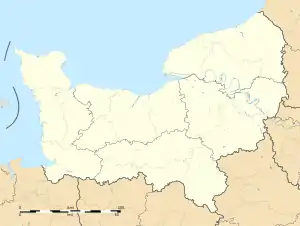Saint-Pierre-lès-Elbeuf | |
|---|---|
 A floral display at the entrance to Saint-Pierre-lès-Elbeuf | |
 Coat of arms | |
Location of Saint-Pierre-lès-Elbeuf | |
 Saint-Pierre-lès-Elbeuf  Saint-Pierre-lès-Elbeuf | |
| Coordinates: 49°16′41″N 1°02′29″E / 49.2781°N 1.0414°E | |
| Country | France |
| Region | Normandy |
| Department | Seine-Maritime |
| Arrondissement | Rouen |
| Canton | Caudebec-lès-Elbeuf |
| Intercommunality | Métropole Rouen Normandie |
| Government | |
| • Mayor (2020–2026) | Nadia Mezrar[1] |
| Area 1 | 6.36 km2 (2.46 sq mi) |
| Population | 8,285 |
| • Density | 1,300/km2 (3,400/sq mi) |
| Time zone | UTC+01:00 (CET) |
| • Summer (DST) | UTC+02:00 (CEST) |
| INSEE/Postal code | 76640 /76320 |
| Elevation | 4–75 m (13–246 ft) (avg. 20 m or 66 ft) |
| 1 French Land Register data, which excludes lakes, ponds, glaciers > 1 km2 (0.386 sq mi or 247 acres) and river estuaries. | |
Saint-Pierre-lès-Elbeuf (French pronunciation: [sɛ̃ pjɛʁ lɛ.z‿ɛlbœf], literally Saint-Pierre near Elbeuf) is a commune in the Seine-Maritime department in the Normandy region in northern France.
Geography
A small suburb town of farming and light industry situated by the banks of the Seine, some 14 miles (23 km) south of Rouen at the junction of the D921 with the D321 and the D913 with the D86 road. The old quarries have some interesting geological strata examples.
Population
| Year | Pop. | ±% p.a. |
|---|---|---|
| 1968 | 4,456 | — |
| 1975 | 6,449 | +5.42% |
| 1982 | 7,994 | +3.12% |
| 1990 | 8,411 | +0.64% |
| 1999 | 8,417 | +0.01% |
| 2007 | 8,332 | −0.13% |
| 2012 | 8,338 | +0.01% |
| 2017 | 8,202 | −0.33% |
| Source: INSEE[3] | ||
Main sights
- The church of St.Pierre, dating from the 19th century.
- The church of St.Louis, also dating from the 19th century.
- The 18th-century château du Parc.
Twin towns
 Rieti, Italy
Rieti, Italy
See also
References
- ↑ "Répertoire national des élus: les maires" (in French). data.gouv.fr, Plateforme ouverte des données publiques françaises. 13 September 2022.
- ↑ "Populations légales 2021". The National Institute of Statistics and Economic Studies. 28 December 2023.
- ↑ Population en historique depuis 1968, INSEE
External links
Wikimedia Commons has media related to Saint-Pierre-lès-Elbeuf.
- Website about Saint-Pierre-lès-Elbeuf (in French)
This article is issued from Wikipedia. The text is licensed under Creative Commons - Attribution - Sharealike. Additional terms may apply for the media files.